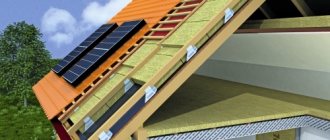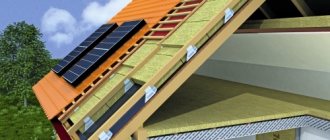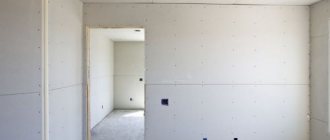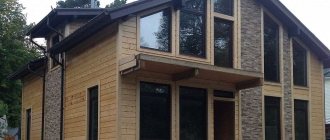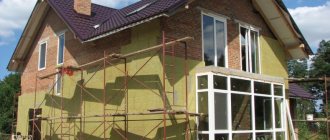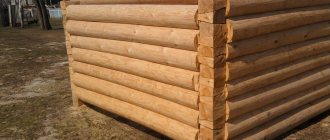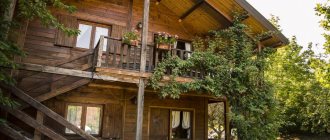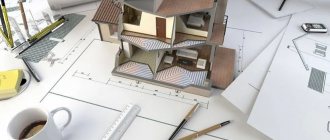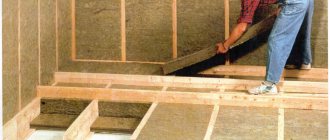Wood and plastic are well-known and widely used materials, and each of them has its own pros and cons. Until recently, the disadvantages of using plastic and wood were minimized with the help of special additives and impregnations, but modern technologies make it possible to create completely new, revolutionary materials. One of them is called wood-polymer composite (WPC), or simply liquid wood.
Facade board made of wood-polymer composite
Planken
Planken is a board planed on four sides. Its long edge can be straight (with or without a tongue-and-groove system) or beveled at an angle of 35-70º. This type of cladding board is used both inside and outside. It can be mounted vertically, horizontally or diagonally.
The raw material for the production of planken is pine, spruce, linden, beech, oak, etc. wood. The most durable board is made from larch, but this species is quite hard and therefore difficult to process. In addition, it is by no means cheap.
By the way, planken, in principle, costs more than conventional lining, mainly due to the high labor intensity of production. But these costs are recouped (at least partially) due to the fact that the board does not require mechanical post-processing. After covering, the front surface must be covered with a protective preparation (paint, oil wax or tinted antiseptic) and, in fact, that’s all.
Planken with a locking system is not suitable for cladding facades. Under the influence of atmospheric moisture, wood inevitably swells, and the tenons simply tear the grooves
The width of a standard lamella can be from 7 to 14 cm, and the maximum length reaches 6 m. As for thickness, there are only three options: 1, 1.5 or 2 cm. Obviously, the thickest board should be used for cladding facades.
General information
To give the house a certain appearance, the house is clad with overlapping boards. This is one of the finishing options.
Relevant for country styles. The finishing is done with an overlap or a herringbone pattern.
Here the board sits one on top of the other and goes from bottom to top. This allows you to get a sloping Christmas tree. Yes, from an economical standpoint, this is not the cheapest option. But reliable and durable.
Edged and unedged boards are used in the work.
The first is distinguished by perfectly smooth sides with a rectangular cross-section. The thickness is the same along the entire length. After finishing, it is covered with varnish and paint.
Unedged boards are called boards made from solid logs. It is sawn along the grain into lamellas and also has untreated end sides. Bark, sapwood, etc. remain along the edges.
To recreate the effect of a Texas house from a bygone era, you can use unedged boards. But it may take a lot of wood putty to remove all the defects. And you already know how to fix the flaws from the article at the link. The choice is yours.
Block house
This type of cladding can be recommended to those who want to give an unassuming “frame” the appearance of a real log house. The imitation is achieved thanks to the rounded shape of the front surface. When joined, such boards form a surface reminiscent of a log house wall.
One wide groove or several narrow ones can be cut on the back side of the block house. They are needed, firstly, to relieve the internal stresses of the wood, and secondly, to ventilate the space under the cladding.
The length of the board is from 1.5 to 6 m. The thickness “at the crest of the wave” varies from 2 to 4.5 cm, and the width from 9.6 to 19 cm. The impressive dimensions provide the block house with strength and durability. This type of cladding can last for decades. Of course, if it is made conscientiously.
The quality of a block house (as well as other lumber) is regulated by two standards - Russian GOST 8242-88 and European DIN 68126/86. But there is also a simplified market classification.
Grade "A"
should not have any defects other than healthy, fused knots and roughness on the underside of the lamella.
Variety "AB"
tolerates dark but well-adhering knots, as well as minor cracks and machining defects.
Grade "C"
- lumber of the lowest quality. In this case, both falling knots and deep cracks are acceptable. It is highly undesirable to use such a board for exterior decoration. In the difficult climate of central Russia, it will not last long.
Classification by section shape
The board for finishing the facade of a house may also differ in cross-sectional shape:
- Block house. The panels are installed close to each other.
- American. The fastening is carried out with an overlap, which provides reliable protection to the building wall from the penetration of steam and moisture.
- EVRO. Wide panels have several protrusions and grooves, with the help of which the panels are mounted.
- Decking. The surface is absolutely smooth. More often used for flooring, less often for building cladding.
Imitation of timber
We are talking about a board with chamfers beveled at an angle of 40º and a tongue-and-groove locking system. In fact, this is another type of lining, differing from its ancestor only in the shape of the edge and size. The thickness of the product varies from 1.8 to 4 cm, the width is 11-20 cm, and the length reaches 6 m.
Important!
For exterior decoration, you should choose the most massive imitation of timber - at least 2.5 cm thick and 15 cm wide. The length should be such that one lamella is enough for the entire wall. If the facade is long and 6 m is not enough, the joints that arise during the cladding process should be covered with wooden planks.
And this is not a matter of aesthetics. The fact is that the ends of the boards are most vulnerable to changes in temperature, humidity and other aggressive climatic phenomena. If they are not protected, the wood will quickly begin to dry out and crack. Imitation timber is made mainly from softwood boards - pine and spruce. Luxury cladding is made from larch wood
Technological process
There should not be any difficulties during the installation process. Although there are many methods for reliable fixation of the facing coating, manipulations are performed according to a general analogy. It is required to follow the manufacturer's advice and have basic construction skills. The cladding can be done with your own hands, without the involvement of professionals.
Important! The facade board is easy to process and easy to use. To work with it, no specialized tools or devices are required. You can easily cope with improvised devices that any man can find in his household.
Sequence of overlapping sheathing work
The sequence of the technological process of decorating the facade of a building:
- The façade part of the wall is marked.
- The wooden frame is fastened using wooden slats.
- If it is necessary to provide additional thermal insulation of the building, insulating material is placed into the cavity of the frame. It is being fixed.
- Facade boards are attached to the frame. The work is done from the bottom up. The evenness of the fixation is controlled using a building level. Self-tapping screws or nails are used as fastening elements.
Important! Experts advise fixing the facing material in a checkerboard pattern. The possibility of deformation of the façade finishing is eliminated. Otherwise, it may lead to deformation of the fibers.
- The width of the plank is 10 cm. The overlap is 2-3 cm on each side. The proportion is maintained over the entire area of the façade.
- The joining of elements along the length is carried out using even strips.
Vertical finishing
Fixation of individual elements is carried out using the tongue-and-groove type.
Vertical cladding
Sequence of work:
- The façade of the building is being marked.
- Fix the main guides. Vertical finishing requires strictly horizontal guides. For this, a building level is used.
- Thermal insulation material is being laid.
- The boards are fastened vertically to the wooden frame using self-tapping screws or nails. Hidden or open fastening method is used.
- Reliable adhesion of the lock of individual façade elements is ensured by knocking them in with a wooden hammer.
- Butt joints are masked with butt strips.
Finishing with flashings and staggered
Reducing possible deformations during vertical fixation of the façade board is achieved by installing the cladding with strips or staggered. The execution methods are similar. The difference lies in the use of boards of different widths located between the main boards.
The strips are presented in the form of ordinary wooden slats. They are mounted between the main facing material, forming a special gap. Internal ventilation of the façade is ensured. When the main board acts as a flashing, the cladding is performed using the staggered method.
Important! The technology of work is typical for cladding facades with unedged boards.
Scandinavian motifs
The main feature of the Scandinavian building decoration motif is the use of wood elements and stones. Preference is given to direct and concise forms. A natural palette of colors is used. Design solutions are made using natural boards and their artificial imitation. It is difficult to distinguish the products externally. Characterized by clarity of geometric shapes and lines, play of contrasts. Brown, red, beige and gray tones are used.
Natural materials are preferred, so the foundation is often finished with stone or decorated with a profile imitating it. Wood is used to build walls. You can cover the facade with boards or clapboard. The coating serves not only decorative purposes, but also protects the house from strong winds and precipitation.
The main goal of the Scandinavian style is to achieve environmental friendliness, ergonomics, energy saving and laconic proximity to the outside world.
Bakelite facade plywood
It would seem that plywood is not the material that can be used to cover facades. But oddly enough, its moisture-resistant varieties are used for these purposes. Of course, this finish will not last forever. But if you use a moisture-resistant board and cover it with three layers of protective preparations (for example, primer and double painting), it will last for several years.
The main advantage of plywood is that its sheets have a large area, and this simplifies and speeds up work. This is usually how frame houses, summer kitchens and cabins are finished in regions with a temperate climate. As a rule, slabs with a thickness of 9 to 12.5 mm are used. They are optimal in terms of price, quality and reliability. Sometimes you can find cladding 15 mm thick, but this is rather an exception to the rule. Such massive panels, firstly, are quite expensive, and secondly, they have considerable weight, which can be critical for a “framework” on a shallow foundation.
Of course, thickness is not the only important factor when choosing plywood. The quality of the veneer, the type of glue and the gluing technology matter. Taking into account all these parameters, the material is designated with appropriate markings. FBS plywood has the highest strength, followed by FBS-1 and FBS-1A. FBV boards cannot boast of moisture resistance, and therefore cannot be used for facade work.
Moisture-proof plywood must be coated at the ends with bakelite varnish or special enamel. Without this protection, the sheet will quickly begin to delaminate.
What is WPC
From a technical point of view, WPC is a mixture of wood flour (crushed wood fiber), non-flammable polymers, additives (special additives) and dyes. The main components are mixed and extruded into facade panels made of wood-polymer composite of the required length using extrusion.
The percentage of materials varies, the wood content can reach from 60 to 70% in some cases. Manufacturing technology allows us to preserve the positive properties of the original materials and neutralize their shortcomings.
Burnt board
Having talked about the main types of cladding for facades, let's move on to technology. As mentioned above, when working outdoors, the board must be painted or coated with protective preparations. But you can do without “chemistry”. To make wood impervious to moisture, ultraviolet radiation, rot, insects, etc. need... to burn it.
Firing options
Surprisingly, a regular gas burner turns wood into an almost invulnerable material. The melted resin closes the pores like glue. Under the influence of high temperatures, the sugars contained in the juice decompose - food for harmful microorganisms. And the soot settling on the surface makes the board difficult to ignite.
Resinous woods such as cedar, pine, spruce, etc. perform best when fired. However, other breeds can be treated in a similar way. But you need to work with a gas torch or a blowtorch. On a regular open fire, the material chars too much and loses its strength.
Burnt wood does not require painting or impregnation with protective agents. Moreover, its lifespan is calculated in decades
Coating
Coating with protective oils in production conditions costs +1200 rubles/m2. The service includes: sanding, coating the bottom side in 1 layer, coating the front side in 2 layers. We use only proven materials Kreidezeit and Leinos, in our assortment there are more than 50 possible shades to choose from.
Thermal ash
Thermal pine
Any natural wood must be protected with high-quality tinted oils from:
BURNOUT. When exposed to sunlight, the wood begins to fade and over time acquires a dirty gray tint. At the same time, ONLY tinted oils protect against burnout. DIRT AND DUST. When various particles of dirt and dust fall on an unprotected surface, they begin to destroy it. Also, contaminants can be deeply absorbed into the porous surface of the wood and leave unpleasant stains that will be very difficult or impossible to sand off. CRACKS. When water hits a surface unprotected by oil, it is instantly absorbed into the porous surface of a living tree. When the temperature drops, moisture crystallizes and cracks appear on the surface of the wood, which spoils the appearance of the decking. It is also necessary to protect the ends, this is the weakest point of a living array.
We recommend covering the planken not only on top, but also on the bottom. Below you can use any cheap compounds. This inexpensive symbolic layer on the back of the deck will provide additional protection.
Thermowood
You can harden a board not only by firing. Factory treatment of wood with hot steam is even more effective. At high temperatures (185–205°C), the sugars contained in the juice, which we discussed above, burn out. But that is not all. The surface layers of the board become much denser, which means water absorption is reduced. Moreover, it decreases significantly – by 3–5 times. This means that such cladding will not care about rain and snow.
Heat treatment has another noticeable advantage. The board ceases to be sensitive to fluctuations in temperature and humidity. This means that it will not swell and dry out on the facades, gradually tearing out the fasteners.
However, it’s worth talking about fasteners separately. The high density of thermowood makes it prone to splitting. To prevent cracks from appearing on the board when hammering nails or screwing in self-tapping screws, preliminary drilling is necessary, and this adds hassle to the installers.
Special clamps have been developed for heat-treated wood that allow for hidden fastening
All other things being equal, thermowood costs 2-2.5 times more than simple lining. But this is not the whim of the manufacturers. The fact is that before hardening with heat and steam, the raw materials are carefully selected. Boards with knots, resin pockets, fungal infections, etc. are discarded, since all these defects will manifest themselves in the oven. This, as well as the complexity of production, explains the high price.
Peculiarities
Facade board is a finishing material used to cover the external walls of residential buildings. Technically, it is a product based on natural wood, which can be subjected to special processing. Such influences can even change the structure of the material, which increases its technical characteristics.
Facade boards can have different sizes and shapes, but externally the product is endowed with a structure that is completely identical to natural wood. This applies to varieties, the production of which involves the introduction of additional polymer components into wooden surfaces.
Facade boards for exterior finishing are widely used in construction. It differs from ordinary wood in being more resistant to external factors.
Particular attention should be paid to painted materials or thermal boards
The main purpose of the facade board is to decorate facades - it cannot be used as a protective material, since its characteristics do not allow creating optimal thermal insulation conditions.
Slatted facade
A slatted façade is a system of posts and boards fixed (vertically or horizontally) at wide intervals. In essence, these are blinds that are “dressed” not on windows, but on walls.
Designs of this kind are popular mainly in countries with hot climates, that is, where reliable protection from the sun is needed. But they are also found in Europe, and recently in our country. This is a light, airy and, importantly, relatively inexpensive finish that can be an excellent home decoration.
Making a slatted facade is quite simple. It will require racks with a cross section of 5×5 or 10×10 cm (depending on the loads) and boards or bars with a thickness of at least 2 cm. They are fixed vertically, horizontally or diagonally. And if you show your imagination, you can create a complex and expressive pattern.
Theoretically, any wood can be used for a slatted facade, but pine or spruce will not last long. But larch will decorate the house for many years and even decades. The same applies to heat-treated and fired boards.
Advantages and disadvantages
A house made from unedged boards looks original despite the budget. Finishing with overlapping workpieces does an excellent job of draining rainwater, as it creates an obstacle to the penetration of precipitation into the coating and a slope for gravity flow. Thus, if protective measures are taken, the cladding will last for several decades.
Also important advantages include the following points:
- low thermal conductivity of wood and air cushion between the base and finish;
- the gap in the cladding structure ensures natural ventilation of the facade;
- good vapor permeability of wood contributes to the rapid drying of the finish, that is, the formation of condensation inside the structure is virtually minimal.
There are few disadvantages that can be identified. One of them is the high consumption of lumber due to overlap. That is, the working width of unedged or prepared boards for finishing a house will be reduced by the recommended 20 mm.
The second disadvantage comes down to the woody nature of the sheathing. It requires mandatory treatment with compounds against fungus, mold and anti-fungus additives.
Universal wood protection product Source cloudinary.com
The end parts, so that they do not rot from the active influence of natural phenomena, also need to be impregnated and covered with decorative corners. Additionally, the finish can be painted with paints and varnishes for wooden facades.
